More
colorful PCC cars coming to San
Francisco!
***
The Times has learned that San Francisco has acquired additional PCC cars. These cars had operated until 2002 in Newark, NJ. They had been stored under Pennsylvania Station during their service in Newark and were in excellent condition considering their age. The cars are now at Brookville Equipment in Pennsylvania for rehabilitaion and the first of them should be in San Francisco for testing in May. A coordinated plan for the paint schemes to be used on these cars was issued in April 2004 as a result of a joint effort by the San Francisco Municipal Railway and the Market Street Railway Company. There have been minor changes in the plan for many reasons but as of today, according to the spring 2005 issue of the Inside Track, the official quarterly of the Market Street Railway, the ex-Newark cars are to be numbered and painted as follows:
1070
- Newark, NJ - Public Service Coordinated
Transport (dark gray/blue/white)
1071 - Minneapolis, MN - Twin Cities
Rapid Transit (chrome yellow/green)
1072 - Mexico, City, Mexico - Servicio
de Transportes Electricos del Distrito
Federal [STEDF] (cream/red/gray)
1073 - El
Paso, TX - El Paso City Lines (green/white/red)
1074 - Toronto, ONT - Toronto Transportation
Commission (maroon/cream)
1075 - Cleveland, OH - Cleveland
Transit System (golden brown)
1076 - Washington, DC - D.C. Transit
(aqua green/persimmon/white)
1077 - Birmingham, AL - Birmingham
Electric Company (red/cream/blue)
1078 - San Diego, CA - San Diego
Electric Railway (light green/ brown/cream)
1079 - Detroit, MI - Department
of Street Railways (cream/red/white
1080 - Los Angeles, CA - Los Angeles
Transit Lines (yellow/green/white)

This plan is the result of extensive coordination between Muni and the Market Street Railway. They both collaborated on a plan for the ex-Philadelphia cars and have even more worked together on plans for these next cars. Muni accepts the Market Street Railway desire for authenticity and Market Street Railway accepts the realistic approach to limiting paint color stocks that Muni must face.[You never would find such intelligent coordination and planning at most other transit systems, such as SEPTA in Philadelphia.]
If Muni was to acquire more PCC cars from New Jersey, there is already a plan for them. These cars would be painted in the following schemes:
Shaker
Heights, OH - Shaker Heights Rapid
Transit (yellow/green/gray)
Pittsburgh, PA - Pittsburgh Railways
Co (red/cream/black)
Cleveland, OH - Cleveland Transit
System (golden brown/orange/cream)
Johnstown, PA - Johnstown Traction
Co (orange/sand/light gray)
If any of the remaining 1006-1015 class double end PCC cars are ever rehabilitated, the current plan calls for:
Car
1006 - Muni "Wings" -
similar to current car 1050 (green).
Dallas, TX - Dallas Railway &
Terminal Company (red)
Boston, MA - Boston MTA - similar
to current 1059 (orange)
Boston, MA - Boston MTA (red with
circle T logo)
Dallas, TX - Dallas Railway &
Terminal Company (cream)
There are even considerations for repainting some of the 1050-1063 series cars considering the recent additions:
1-1060
is to be repainted in PRT (Philadelphia)
cream and silver replacing the seriously
wrecked 1054 [Already done];
2-1050 would be repainted in Vancouver,
B.C. colors (red/cream)*;
3-1051 would be repainted in Montreal,
Quebec (cream/red)*.
*
These repaints would occur if some
of Muni's own 1016-1040 class, such
as those cars recently obtained
from the Orange Empire Railway Museum
are funded for rehabilitation. Naturally,
those cars, including 1040, would
be repainted in their original Muni
"Wings" and Muni "Simplified"
paint schemes.
See more details of the San Francisco
plan at www.streetcar.org.
_______________________________________________
Pomona
Club Forced to Relocate!
***
More bad news for Southern California Model Railroaders came this month as the Pomona Valley Model Railroad Club had been notified that their lease would not be renewed and that their layout would have to be removed from the premises by July 1, 2005. The club held what may be their last Swap Meet & Open House on April 9th. The club has existed since 1959 and this location at 132 East 1st Street in Pomona, CA had been their fourth facility during that forty-six year span.
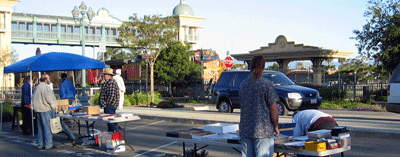
This swap meet, held in full view of the Union Pacific Railroad (notice the UP locomotive passing the the background in the above photo) and a new Metrolink station, was always free to shoppers but donations were gladly accepted. Refreshments were always available.
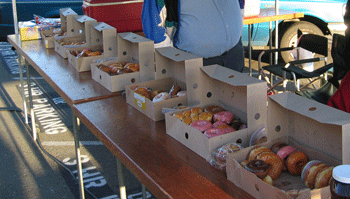
The second floor of this commercial building had been the home of the layout for over 25 years. The layout depicted the Sierra, Cajon and Pacific RR, an HO scale free-lanced Class railroad that ran between the West Coast seaport town of Pacific and terminated at the eastern town of Sierra, where it connected with other Class 1 railroads. There was even a trolley line in downtown Woodward complete with ORR girder rail, turnouts and crossings.
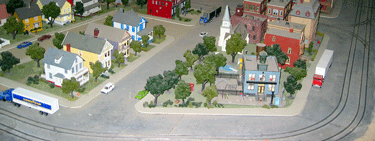
Woodward was just a small portion of the layout which was housed in a room 30 by 120 feet.
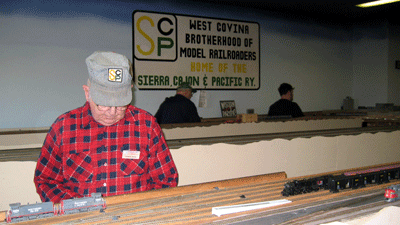
If the club finds another location prior to July 1, they may be able to save a lot of the current layout. Otherwise most of the long years of work on this layout will be lost. So if you know of a facility in the Pomona area that the club could use, please contact the club at 909-865-7035, view their web site at www.pvmrrc.com and email them at the address specified!
Points
In Trolley History - 4
***
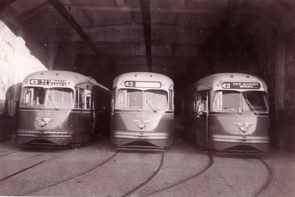
The above photo shows Philadelphia cars 2719 (1947), 2121 (1948) and 2127 (1948) resting in Callowhill Barn in West Philadelphia on October 31, 1948. Car 2719 was just over one year old and cars 2121 and 2127 were less than a year old when the photo was taken. At that time, they were the pride of Philadelphia and the residents adjacent to Callowhill Barn were proud to have them in the neighborhood. Car 2121 (center) went on to survive through the SEPTA era until 1993 when sold to San Francisco, where is became 1054 and was dressed in the 1938 PRT original PCC blue and silver scheme as shown below:
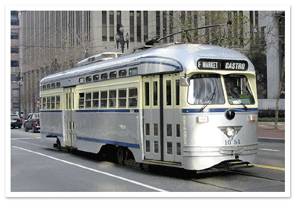
However, this car was badly wrecked a few years ago when hit by a Breda LRV being operated by the same (now former) MUNI operator that had wrecked PCC 1060. Muni 1060 now wears the colors formerly displayed by 1054. Car 2719 shows two destination signs, 63-LANCASTER, 63-MARKET. It would not be until 1968 when PCC cars of this class would be operated on Route 10 to 63-LANCASTER, while by 1955, these cars would be in service on Route 41 to 63-MARKET. The PTC had grand plans for these cars before National City Lines took control.
_______________________________________
Upgrades for the Boeing SLRV mechanism!
***
Since the beginning of this year, these SLRV mechanisms have been available from Custom Traxx. San Francisco and Boston HO scale modelers have been steadily acquiring the units while Custom Traxx and the Southern California Traction Club have been experimenting with the units to see which enhancements could be made.
Of course, the A-line 20040 Bowser flywheel units were considered almost mandatory for any of the Bowser 1999 drives. Right up front, we knew there was going to be a weight issue with these plastic shells. The 1999 Bowser drives were designed considering the weight of the Bowser shells. Those of us who operate these units under powered overhead wires are well aware of the requirement to have sufficient weight in the cars to offset any forces placed on the car by the trolley pole or pantograph, especially if only 50% of the wheels are powered. Custom Traxx uses a simple "rule of thumb" for calculating the weight of any powered car using a pole or pantograph to collect power. This formula was based on the weight of the Bowser PCC shell, namely one ounce of weight for every five feet of vehicle. The 71' Boeing SLRV would have to weigh about 14.2 ounces under this formula. Fortunately, this formula may not be a purely linear function and less weight may suffice.
The 125147 SLRV mechanism weighs around 5.2 ounces right out of the box. The entire SLRV shell, consisting of two major body sections and the transition or articulation section weighs only 1.0 ounce. This unit has eight of twelve wheels powered and will operate two-rail as delivered. For the normal two-rail operation, this unit will be excellent, far surpassing the original 4 wheel powered unit. It is left to the modeler to install the couplers of choice. But for the modeler wishing to operate the cars from overhead wire, more weight will be required.
Adding two A-line 20040 flywheel kits will bring the total weight up to about 7.2 ounces. To ensure correct tracking of the center truck, we added two 1 ounce weights under the floor between the trucks to each half of the body. To secure these weights, we removed a little material from each weight to clear the motor mount screws. Now the total chassis weight was 11.2. ounces. Substituting the A-line 40322 motors for the Bowser motor and motor mounts, mounting them with Aquarium Sealer, brought our latest chassis weight to 11.5 ounces. This 11.2 to 11.5 ounces will be our test weight for the two new test units. The unit shells were stripped, repainted and finished with the new Custom Traxx CN-1220 San Francisco SLRV decals. They have been numbered 1220 and 1213 and will have both pantographs and trolley poles.
NOTE 1: We have found that the tightness of the center truck screw affects the operation of the unit over rough track. The nut should be tightened just enough to hold the center truck and transition section but loose enough to allow vertical movement of both halves of the unit. We have discussed some possible modifications to the floor with Bowser to eliminate this problem.
NOTE 2: When using the A-Line 40322 motor, there is insufficient clearance over the motor to permit any wires. All wires must be relocated to the sides of the unit where they will not interfere with the roof of the shell. We have discussed some possible modifications to the floor with Bowser to eliminate this problem.
Shown below is one of the finished units, SFMR 1220, taking the crossover on one of the Southern California Traction Club modules
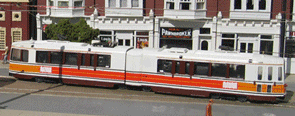 _______________________________________
_______________________________________
Custom Traxx to display items at East Penn Meet!
***
Custom Traxx will be displaying the new Bowser SLRV units mentioned above along with the complete line of bowser traction drives at the East Penn Meet to be held in Philadelphia, PA on May 13-14-15, 2005. Also being displayed will be the ORR Track line, the extensive Custom Traxx line of HO, O and Large Scale Traction decals and special parts for those who operate traction vehicles from overhead wire. This meet will be held at the Pennsylvania National Guard Armory, 2700 Southampton Road, Philadelphia, PA 19154.
Because this is one of the premier model trolley meets, the Los Angeles offices of Custom Traxx will be closed from May 9th to May 16th. All orders received during that time will be filled immediately on May 17th.
The meet begins on Friday, May 13th with dealer, display and layout set-up at 11:00 AM. Registration opens at 6:00 P.M. with a slide/movie presentation at 8:00 P.M.
Saturday activities begin at 9:00 AM with clinics, dealer sales, video presentations. operating trolley layouts in many scales from HO scale to large scale. Another slide/movie presentation occurs at 8:00 P.M. This part of the meet ends at 10:00 PM.
Dessert is served on Sunday by means of a fan trip on one of the local electric railway lines. This year a PCC-II fan trip combined with a Kawasaki MU train on the city lines is scheduled. The MU capability of the single-end Kawasaki cars is rarely used by SEPTA and should be an interesting phenomenon for the shutter bugs to record.